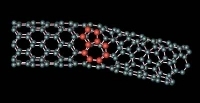 It is stronger than steel and taller than the Empire State Building (well relatively speaking). It was discovered in a pile of black crud, not exactly by accident but pretty close. What are these things? Carbon nanotubes and they were discovered in 1991 by scientists at NEC corporation. Carbon nanotubes are tiny tubes made of carbon, just carbon, nothing else. They are similar to graphite (the stuff that you find in pencils) and if you can imagine, a sheet of graphite that was rolled up into a tube. To make a carbon nanotubes you need methane, a gas and high temperatures using methane. The start to ‘grow’ when you add a tiny piece of metal called a catalyst. Under certain conditions you get a single tube which is about 2 nanometers in diameter. You could take 50,000 carbon nanotubes and lay them across the width of a hair. That’s pretty small. And scientists have figured out how to grow them really long up to a few millimeters. Thats pretty long. The Empire State Building is 1250 feet tall and 187 feet wide (East to West). That means it is 6.6 times higher than it is wide (this is called its aspect ratio). A carbon nanotube that is 1 millimeter long has an aspect ratio of about 1,000,000!
It is stronger than steel and taller than the Empire State Building (well relatively speaking). It was discovered in a pile of black crud, not exactly by accident but pretty close. What are these things? Carbon nanotubes and they were discovered in 1991 by scientists at NEC corporation. Carbon nanotubes are tiny tubes made of carbon, just carbon, nothing else. They are similar to graphite (the stuff that you find in pencils) and if you can imagine, a sheet of graphite that was rolled up into a tube. To make a carbon nanotubes you need methane, a gas and high temperatures using methane. The start to ‘grow’ when you add a tiny piece of metal called a catalyst. Under certain conditions you get a single tube which is about 2 nanometers in diameter. You could take 50,000 carbon nanotubes and lay them across the width of a hair. That’s pretty small. And scientists have figured out how to grow them really long up to a few millimeters. Thats pretty long. The Empire State Building is 1250 feet tall and 187 feet wide (East to West). That means it is 6.6 times higher than it is wide (this is called its aspect ratio). A carbon nanotube that is 1 millimeter long has an aspect ratio of about 1,000,000!
 Carbon nanotubes look like chicken wire, hexagons (six-sided) made of carbon atom. They are interesting because they do cool things. They are strong, very strong, about 100 times stronger than steel. And so scientists dream that you might be able to use carbon nanotubes to make a space elevator. To do this you would need wire woven out of carbon nanotubes that was hooked on one end to a satellite and on the other to earth. So instead of a rocket, you would just lift yourself into space. But the real interest in carbon nanotubes is because they can act as semiconductors. Semiconductors are materials that under certain conditions conduct electrons and under other conditions they act as insulators. You can use semiconductors to make transistors, tiny switches that are turned on and off by electrons. So imagine a transistor that is 2 nanometers. In computers now a days, transistors are about 100 nanometers. In theory you should be able to pack about fifty times more transistors into a computer chip. Well you could if you could figure out how to use carbon nanotubes. But carbon nanotubes are really hard to control and because they are so small it’s really hard to move them around. So scientists use the tiny tips of atomic force microscopes to move them around and put them where they want. It is slow but it works.
Carbon nanotubes look like chicken wire, hexagons (six-sided) made of carbon atom. They are interesting because they do cool things. They are strong, very strong, about 100 times stronger than steel. And so scientists dream that you might be able to use carbon nanotubes to make a space elevator. To do this you would need wire woven out of carbon nanotubes that was hooked on one end to a satellite and on the other to earth. So instead of a rocket, you would just lift yourself into space. But the real interest in carbon nanotubes is because they can act as semiconductors. Semiconductors are materials that under certain conditions conduct electrons and under other conditions they act as insulators. You can use semiconductors to make transistors, tiny switches that are turned on and off by electrons. So imagine a transistor that is 2 nanometers. In computers now a days, transistors are about 100 nanometers. In theory you should be able to pack about fifty times more transistors into a computer chip. Well you could if you could figure out how to use carbon nanotubes. But carbon nanotubes are really hard to control and because they are so small it’s really hard to move them around. So scientists use the tiny tips of atomic force microscopes to move them around and put them where they want. It is slow but it works.
